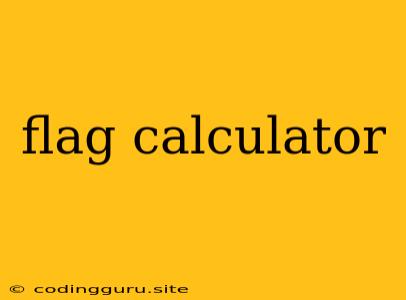What is a Flag Calculator?
A flag calculator is a tool that helps you understand and manipulate binary flags. These flags are often used in programming languages like C, C++, and Java to represent different states or options within a variable. Think of them as individual switches that can be toggled on or off.
Why use a flag calculator?
- Clarity: Flags can be confusing to work with when you're just looking at raw binary numbers. A flag calculator presents them in a more human-readable format, often with descriptive labels.
- Ease of Manipulation: The calculator allows you to easily set, clear, and check flags without needing to delve into the intricacies of bitwise operations.
- Debugging: If you're facing issues with your code that involve flags, a calculator can help you identify the problem by clearly showing you the current state of each flag.
How does a flag calculator work?
- Define your flags: You start by defining the names and associated bit positions of the flags you want to use. For example, you might define flags called "READ", "WRITE", and "EXECUTE" with bit positions 0, 1, and 2 respectively.
- Input the flags: The calculator provides a user interface to let you input the current value of your flags, either in binary, decimal, or hexadecimal format.
- Visualize the flags: The calculator will display the flags in a clear format, showing the name and status (on or off) of each flag.
- Manipulate the flags: You can use the calculator to set, clear, toggle, or check individual flags, or combine multiple flags into a single value.
Example:
Imagine you have a flag called "ENABLE" with a bit position of 3. This flag controls whether a certain feature is enabled or disabled. Let's say you have a variable called "options" with a value of 0b00001000. This means that the "ENABLE" flag is currently set.
You can use a flag calculator to:
- Verify the current state: The calculator would display the "ENABLE" flag as "ON".
- Disable the "ENABLE" flag: You could click a button to clear the flag, resulting in a new "options" value of 0b00000000.
- Enable the "ENABLE" flag: You could click another button to set the flag, resulting in a new "options" value of 0b00001000.
Benefits of using a flag calculator:
- Reduced development time: You can quickly and easily manipulate flags without having to write complex code.
- Improved code readability: Using a flag calculator can make your code more understandable, especially for other developers who may not be familiar with bitwise operations.
- Fewer errors: The calculator helps prevent mistakes that can occur when manually manipulating flags.
Finding a flag calculator:
There are several flag calculators available online, some of which are free and easy to use. You can search for "flag calculator" on your favorite search engine to find a suitable tool.
Conclusion:
A flag calculator is a valuable tool for developers who work with binary flags. It provides a user-friendly way to visualize, manipulate, and debug flags, which can save time, improve code readability, and reduce errors. If you're working with flags, consider using a flag calculator to simplify your development process.
